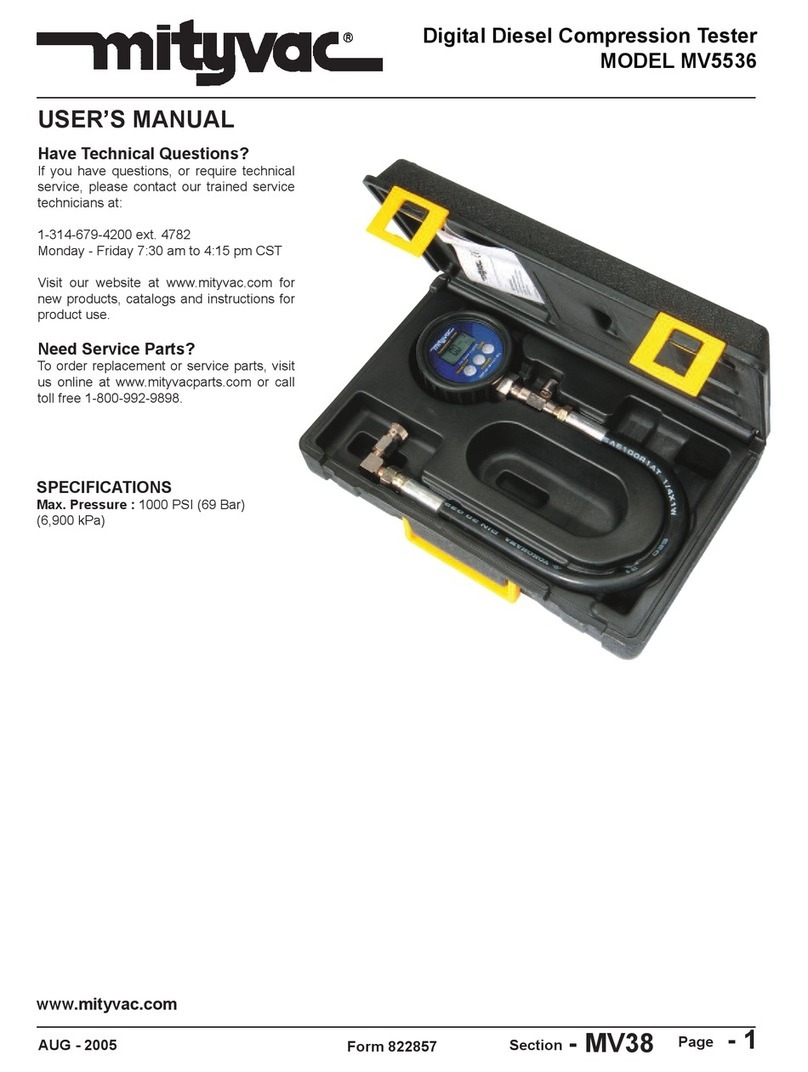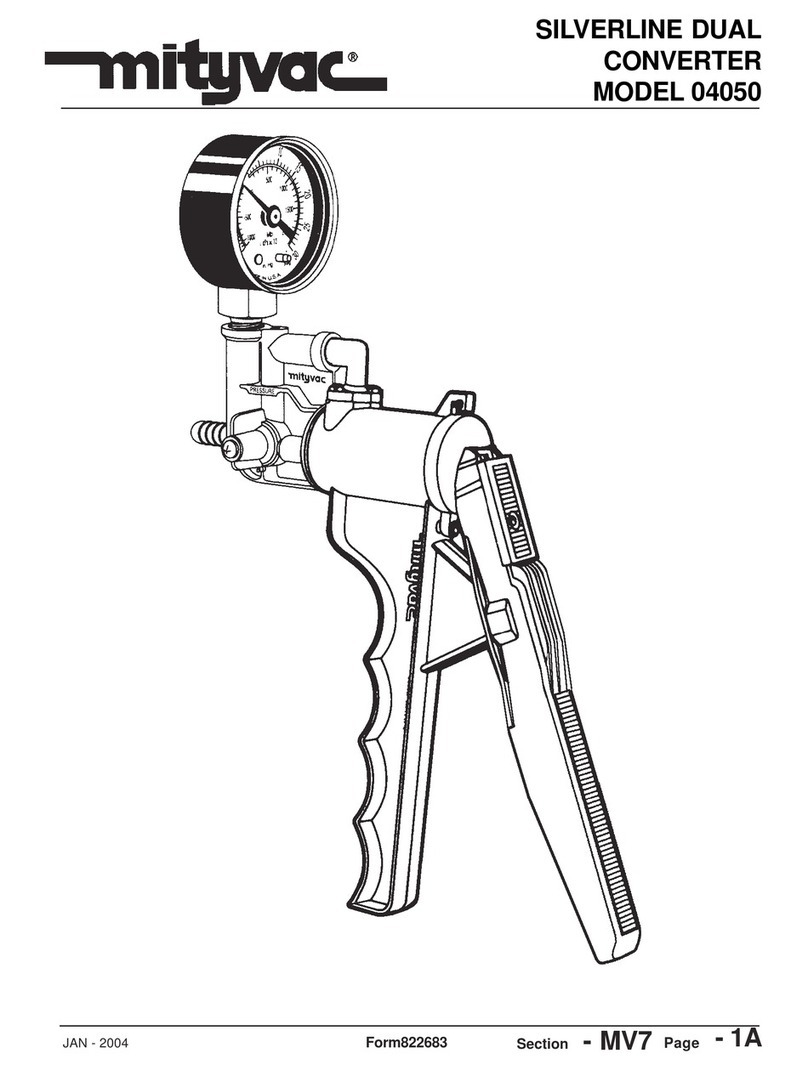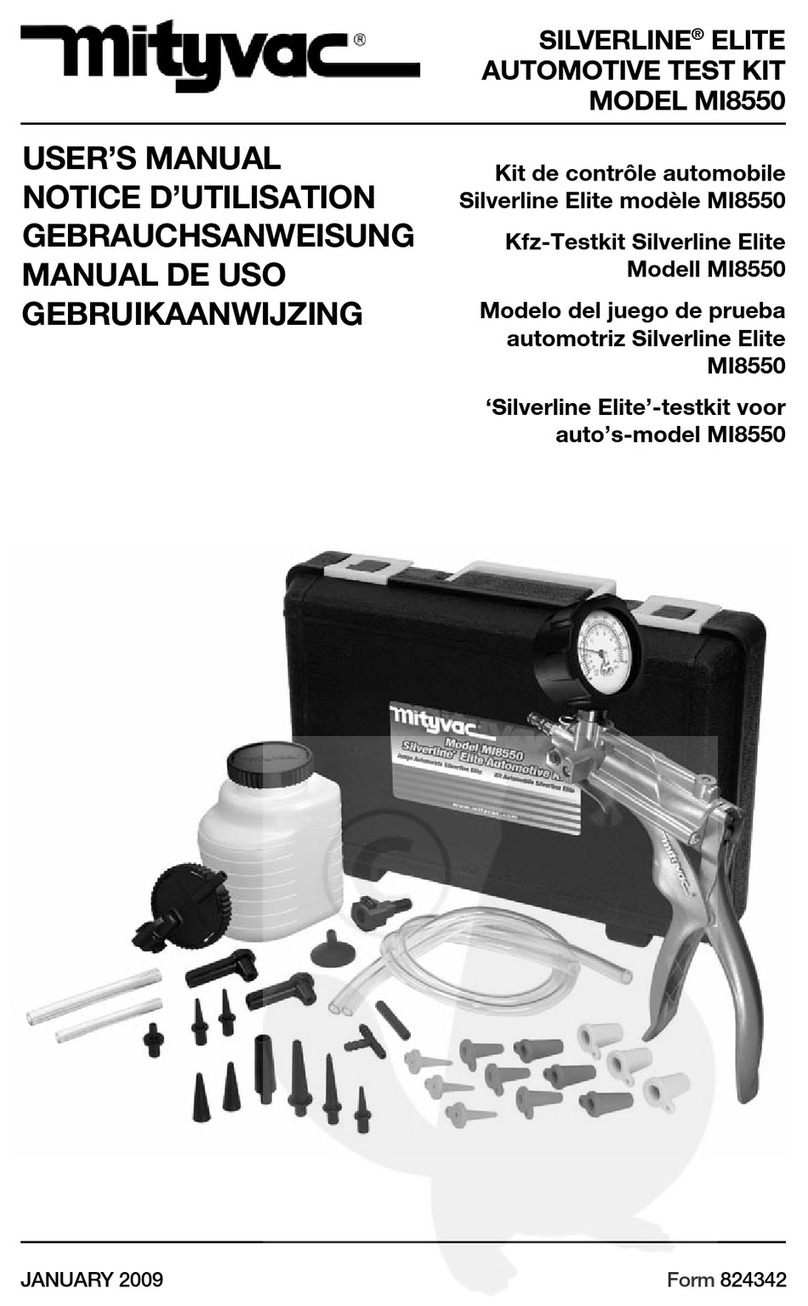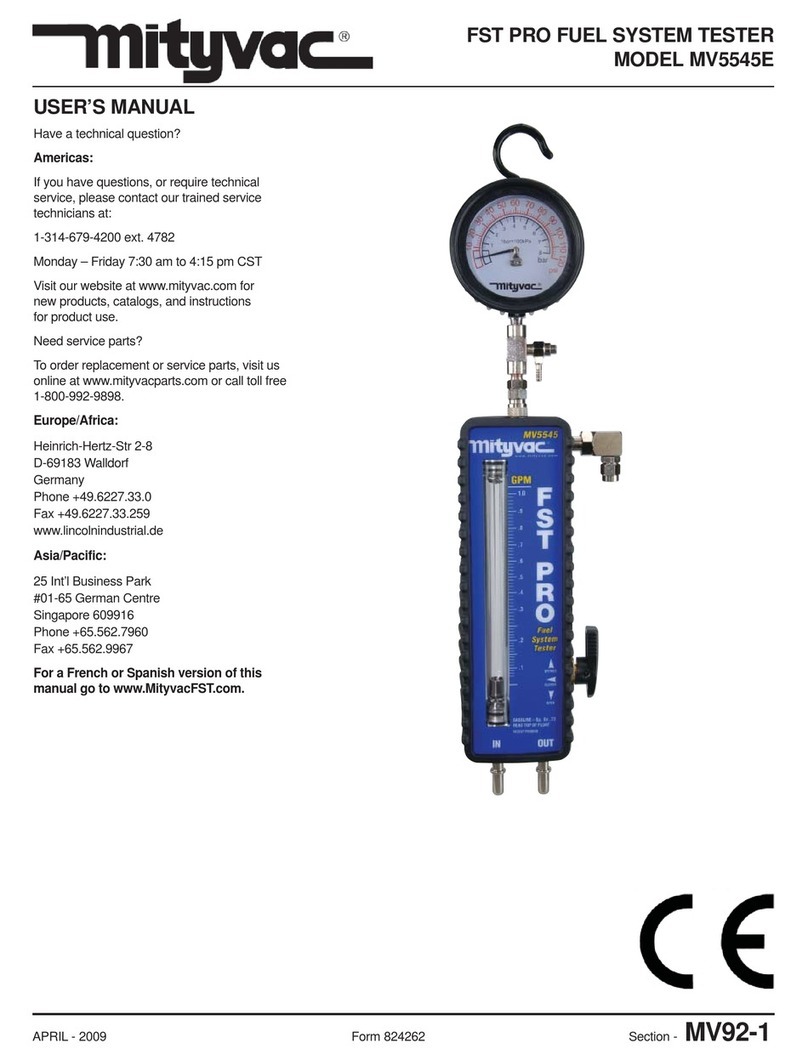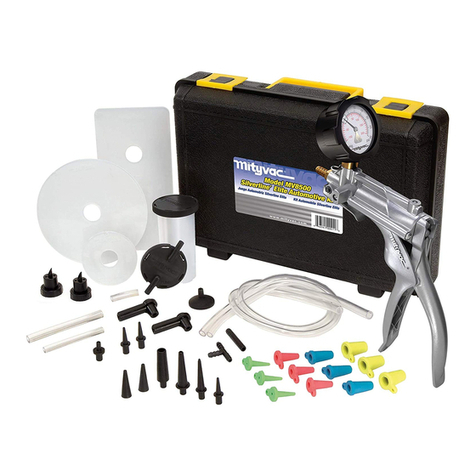
Page Number - 7Form 824255
©Indiquelechangement
TEST DE COMPRESSION PROFESSIONNEL
P/N ©MV5530
Prenez soin de toujours lire les instructions avant utilisa-
tion.
Inclus dans Ce Kit
• Calibrerenforcéde70mm(2¾’’)aveclentillederésistance
élevéeauxchocs,enveloppedecaoutchouc,ettrois(3)
échellesdemesure(psi,kg/cm2,bar),attachéàuntuyaude
250 mm (10’’) et un raccord rapide
• Quatre(4)tuyauxderallonge:
• 165mm(6½’’)longx14mmdepartieletée,courte
• 305mm(12’’)longx14mmdepartieletée,courte
• 305mm(12’’)longx14mmdepartieletée,longue
• 305mm(12’’)longx18mmdepartieletée,courte
• Un(1)adaptateur:14mmdepartieletée,courtex18mmde
partieletée,longue
• Deux(2)adaptateursdemoteurdefaiblecylindrée
• 10mmdepartieletée
• 12mmdepartieletée
• Un(1)adaptateurrapidedupointdebulle
• Unecaissemoulée-souféesurmesure
• Kitdeserviceaprès-vente
Applications
Le Kit/Machine d’Essais à la Compression Professionnel Mityvac
peuteffectuerdesessaisdecompression,secsoumouillés,an
de déterminer la pression produite dans le cylindre d’un moteur. Il
peut aussi être utilisé comme un outil pour pressuriser un cylindre
demoteurandegarderlesvalvesferméeslorsquel’oneffectue
des réparations.
Comment effectuer un essai de com-
pression
Remarques : Précautions et Diagnostic
AVERTISSEMENT : NE PAS utiliser l’interrupteur pendant le
test de compression sur des véhicules à injection de com-
bustible. L’utilisation d’un démarreur télécommandé pour
mettre le moteur en marche est recommandé. Les systèmes
d’injection de carburant sur de nombreux modèles récents
sont déclenchés par l’interrupteur pendant la mise en marche,
cela peut provoquer un incendie ou la contamination de
l’huile moteur par du carburant.
Prenez soin de toujours utiliser une protection pour les yeux
lorsque vous faites des tests de compression.
Un moteur en bon état de fonctionnement produira un certain
niveaudepressionsurchaquecylindre.Normalement,lescylin-
dres doivent rester dans une fourchette de dix points (pour cent)
l’undel’autre,etrespecterlescaractéristiquesdufabricant.La
pressiondoitaugmenterdoucementàchaquesursautdumoteur,
jusqu’àcequ’elleatteigneunpic.
Silapressionneparvientpasàmonter,ousiellerestelamême
aprèsplusieurssursautsdumoteurpuisaugmente,lacausedu
problème est probablement une valve collante.
Si,surdeuxcylindresadjacents,l’unmontreunniveaudepression
de20livresouplusdemoinsquel’autre,onpeutsuspecterune
tête de garniture cassée.
Si un cylindre montre une pression supérieure de 15 livres ou
plusauxautrescylindres,c’estqu’ilyacertainementunamasde
carbone dans le cylindre.
Procédures pour le Test de Compression
Sèche :
1. Se reporter au manuel d’entretien approprié pour les caractéri-
stiquesdecompressionspéciquesaumoteurquevoustestez.
2.Démarrezlemoteuretlaissezluiletempsd’atteindreune
température normale de fonctionnement (environ 15 minutes
habituellement). Arrêtez le moteur.
3. Installez un interrupteur de starter auxiliaire dans le circuit de
démarrage.
4.Engardanttoujoursvosprotectionsoculaires,utilisezdel’air
comprimé pour évacuer avec soin poussière et débris de la
zone environnante des bougies d’allumage.
5.Retirezlesbougiesuneaprèsl’autre,ennotantlenumérode
cylindreduquelchaquebougieaétéretirée,etdisposez-lessur
unesurfaceplaneetpropre.Celavousaideraàidentierles
cylindres à problème en vous permettant de comparer l’aspect
de la bougie au niveau de compression d’un cylindre donné.
À NOTER : En testant les moteurs à deux bougies par cyl-
indre, il n’est nécessaire d’enlever que les bougies situées
du côté de l’échappement.
6. Surlesvéhiculesàdistributeurstandard,branchezlabo-
bine (tête haute tension) du capot du distributeur et mettez-
la en sureté sur une surface adaptée ou bien désac-
tivez l’allumage en débranchant le terminal positif (BAT) de la
bobine d’allumage.
7. Surlesvéhiculesàallumagesansdistributeur(DIS),désac-
tivez le système d’allumage en ôtant le fusible d’allumage
électronique(commande)oudésactivezlecapteurd’anglede
mise en marche.
ÀNOTER:Sereporteraumanueld’entretienappropriépour
savoirquelfusibleoucomposantôteroudéconnecterdefaçon
temporaire.
8.Ôtezleltreàairducarburateuroulecorpsdurégulateuret
placez le lien du régulateur en position régulateur grand ouvert
(WOT).
À NOTER : NE JAMAIS placer quoique ce soit dans le
corps du régulateur ; le moteur pourrait subir des dégâts
internes. Sur les véhicules équipés d’injection gauche [??]
de carburant, ôtez les couvercles de liens du régulateur
(si nécessaire) et placez le lien du régulateur en position
régulateur grand ouvert (WOT).
9. Mettreenmarchelemoteurplusieursfoispours’assurerque
toutcorpsétrangerquiseraittombédanslescylindrespendant
la préparation du test ait été évacué.
10.Sélectionnezlatailledel’adaptateur(14mm,18mmexten-
sioncourteou14mm,18mmextensionlongue,etfairepasser
l’adaptateur dans le trou de la bougie de la tête de cylindre.

